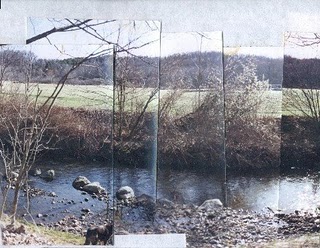The most intact part of the weir; a human construction of boulders about four feet long and two or three feet wide, more or less.
The lower, down-river, end of the weir (above) was relatively intact and partially buried in 1997 (below). By some strange twist of fate, as the saying goes, this person's left foot is very close to a large flat boulder which was moved by the flooding that occurred from Hurricane Irene at the end of August 2011 (as well as a water release at a dam upstream prior to the storm).
Protruding from the present river bed about 14cm (about 5 and a half inches) is a piece of wood that could possibly be either a piece of driftwood that just happened to lodge there naturally or a wooden stake that was inserted there by human hands as part of a working fishweir at some point in time. You could say it is either a "stick" or a "stake." The stake or stick is angeled toward the way water at one time I suspect flowed...
Two cobbles were moved during the flooding, I suspect, while the boulder, the possible stake and another cobble remained relatively intact, more or less still in the diagonal line of boulders and cobbles of the stones used to construct the weir. There are a few more "human enhancements" to the weir, two drill holes in two different boulders:
The word "Nonnewaug" was translated by Woodbury Historian William Cothren as "The Fresh Water Fishing Place." I suspect the "Nonne" part of the Algonquian compound word means "in the middle," attached to the "waug' which often means "fishing place," which a weir certainly would be. Cothren also recorded, as the "land deeds' or treaties do as well, that the Nonnewaug Wigwams were inhabited in 1659 and up to and perhaps after 1700-10. Cothren interperted Nonnewaug's signature to be a snowshoe, while I believe Nonnewaug (or Nunawauk as above) used a picto graph of perhaps an eel basket for his representation of his title as "Sachem Nonnewaug" or "The Keeper of the Peace at the Freshwater Fishing Place (Weir) in the Middle."
Above: a David Wagner painting of Native Americans at a stone fishweir with wooden stakes during the fall migration of eels, capturing eels in baskets.
And after all that, it turns out to be a stick:
On Sept. 21, 2011, I wiggled it, moved some small stones, and wiggled it again. It came out very easily and looks like an unremarkable sycamore stick.
Above: a David Wagner painting of Native Americans at a stone fishweir with wooden stakes during the fall migration of eels, capturing eels in baskets.
And after all that, it turns out to be a stick:
On Sept. 21, 2011, I wiggled it, moved some small stones, and wiggled it again. It came out very easily and looks like an unremarkable sycamore stick.





















Sept. 21, 2011: I wiggled it, moved some small stones, and wiggled it again. It came out very easily and looks like an unremarkable sycamore stick.
ReplyDeleteI have found over 100 such items in NE Florida...they are so cool, sticks, weapons, tools etc and even a dug out remains...good stuff here...
ReplyDelete